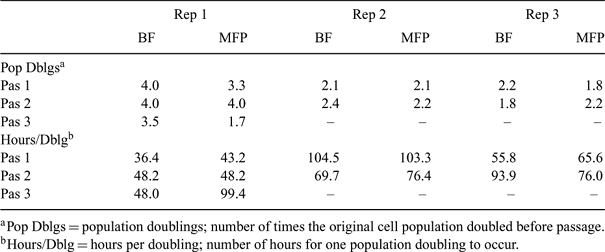125 ISOLATION OF MULTILINEAGE STEM CELLS FROM THE PORCINE MAMMARY FAT PAD
T. Davidson A , S. Lane A , C. Ferguson A , M. Wheeler A B and W. Hurley AA Department of Animal Sciences, University of Illinois, Urbana, IL, USA
B Department of Bioengineering, University of Illinois, Urbana, IL, USA
Reproduction, Fertility and Development 18(2) 171-171 https://doi.org/10.1071/RDv18n2Ab125
Published: 14 December 2005
Abstract
Porcine mammary tissue is a dynamic system that undergoes multiple cycles of growth, differentiation, and regression during the life cycle of a female; however, the mechanisms of mammary morphogenesis are not fully understood. The current hypothesis suggests that epithelial stem cells in the terminal end buds interact with surrounding epithelial and stromal cells during mammary tissue development and regeneration. Because the mammary gland of the virgin animal consists largely of a pad of adipose tissue, we propose that adipose-derived stem cells from the mammary fat pad (MFP) may also play a role in the regeneration process. Therefore, the objective of this experiment was to determine whether multilineage stem cells are present in the MFP of gilts. Adipose tissue from the MFP and back fat (BF) from the loin region were harvested from six nulliparous, cycling Yorkshire gilts, approximately 16 mo of age. Methods for isolation of adipose-derived stem cells were modified from those of Malusky and Wheeler (2004; International Society for Stem Cell Research, Proceedings 2nd Annual Meeting, abstr. 248:124). Presumptive stem cells isolated from each tissue type were maintained in vitro in DMEM supplemented with either 10% newborn calf serum (NCS; Rep 1 and 2) or 10% fetal calf serum (Rep 3). BF and MFP cell types formed colonies of fibroblast-like cells within 3 to 5 d. Growth characteristics are shown in Table 1. When the cells were 80% confluent, they were trypsinized and reseeded into 75-cm2 flasks. When cultured in the presence of NCS, both cell types had a progressive decrease in viability, and these cultures could not be maintained past Passage 4. Differentiation of both cell types (Passage 1) into adipogenic, myogenic, and osteogenic lineages are currently underway. Based on morphological evaluations, both cell types are able to differentiate into the aforementioned lineages; however, differentiation of MFP-derived cells occurred at a slower rate and was less pronounced than that of BF-derived cells. These preliminary findings suggest that the MFP likely contains a population of multipotent stem cells; however, at this time, it is not possible to make meaningful statistical comparisons. Further experiments are needed to fully characterize these cells and determine their role in mammary gland morphogenesis.

|
This study was partially supported by the Council for Food and Agricultural Research (C-FAR) Sentinel Program and USDA Multistate Project (W-1171).


